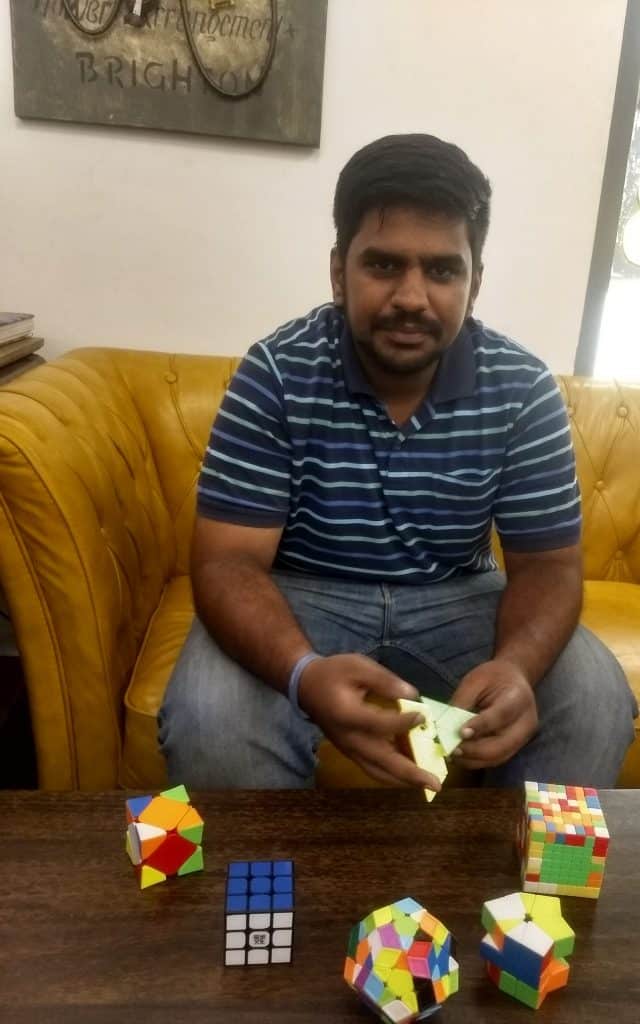How many of us know that a Chennaiite won the National Championship title last month, by solving the 3×3 Rubik’s cube with his feet in 40.81 seconds?
The 20-year-old student of Electronics and Instrumentation engineering from Madras Institute of Technology, Chrompet won the National Championship in the speed cubing competition conducted at IIT-Bombay between 25 and 27 May this year. Around 300 speedcubers from all over the country had taken part in the competition.
Most of us are familiar with the Rubik’s cube. You will find one in most homes that have children but often we hesitate to try and solve it, simply because we are afraid we won’t get it. No such fear in the mind of M A Adithyaa from Namma Chennai, who brought home his fourth consecutive National Championship, with an average time of 40.81 seconds over 5 attempts. Basking in the glow of the title, Adithyaa talks to us about his achievements, stereotypes about the sport and its prospects in Tamil Nadu’s capital.
Believe in practice
Adithyaa begins by wiping away the most common assumption about the Rubik’s cube. “If you think the cube can only be solved by those with high Intelligence Quotient and mental ability, you are wrong. It is solely dependent on practice. You need to adopt a methodology and solve the cube repeatedly,” said Adithyaa. Adithyaa doesn’t practise every day, but ahead of the competition, he attempted to solve it at least a 100 times a day. “All you need is patience to invest time and figure out your method,” he reiterated.
Rubik’s cube works on the principle of group theory in mathematics, in which the relation of each element in a system (the cube) is studied, Adithyaa said as he spoke about the nuances in the puzzle. The theory is broken into a lot of simpler steps and cubers even come up with their own algorithms and solutions, for better understanding and practice.
“The most common method is called CFOP (Cross – First two layers – Orientation of last layer – Permutation of last layer). There are many other methods as well such as Roux, ZZ, etc. These are all various methods coming under, again, the group theory,” explained Adithyaa.
Awards and recognitions
M A Adithyaa has many awards to his credit. He first won the National Championship in 2015 and has won the title every year since then. It is a mind-blowing experience to watch him do the feat with a calm mind, without any signs of tension. Watch him here!
The World Cube Association (WCA), a not-for-profit organisation, conducts speedcubing events all over the world and as a member, Adithyaa has also been an organiser (of speedcubing events). While we are only familiar with the 3×3 Rubik’s cube, he displayed a wide range of cubes (there are eighteen of them)– 2×2 to 7×7, a skewb, pyraminx, megamix and so on. Although he is well versed with all eighteen of them, he chose to master the 3×3 cube – with his feet!!
Beating the previous record for solving by foot, set by Daniel James (average time 45 seconds), Adithyaa solved the same in 41 seconds in 2016, thereby breaking the National Record. There has been no looking back since then – he now has broken his own record 5 times with the latest one being 38.40 seconds. He is ranked 27th in the world with his record and won sixth place in the 2017 World Championship held in Paris. The championship had 1,100 cubers from 72 countries. (Ranking is as of Week of June 4, 2018)
Adithyaa is grateful to his sponsors for helping him pursue his hobby that has turned a passion. “A South Indian restaurant based in Germany called Copper Bowl sponsored me to attend the World Championship last year. A cube distribution company called Cubelelo is sponsoring me this year,” he said.
Chennai’s journey with speed cubing
Speedcubing is a thriving sport in India, and Chennai spearheaded its growth by producing quite a few speedcubers. Yet, there are no formal clubs for the fraternity in the city. “There are many Whatsapp groups where enthusiasts discuss the sport. A majority of the cubers are students, who propagate the sport in their colleges and schools by organising events,” said the speedcuber, wishing for a designated club in Chennai.
“Cities like New Delhi are showing accelerated growth of cubers in recent times. A club and a little more focus in educational institutions of Chennai could do wonders,” Adithyaa said, as he signed off.
